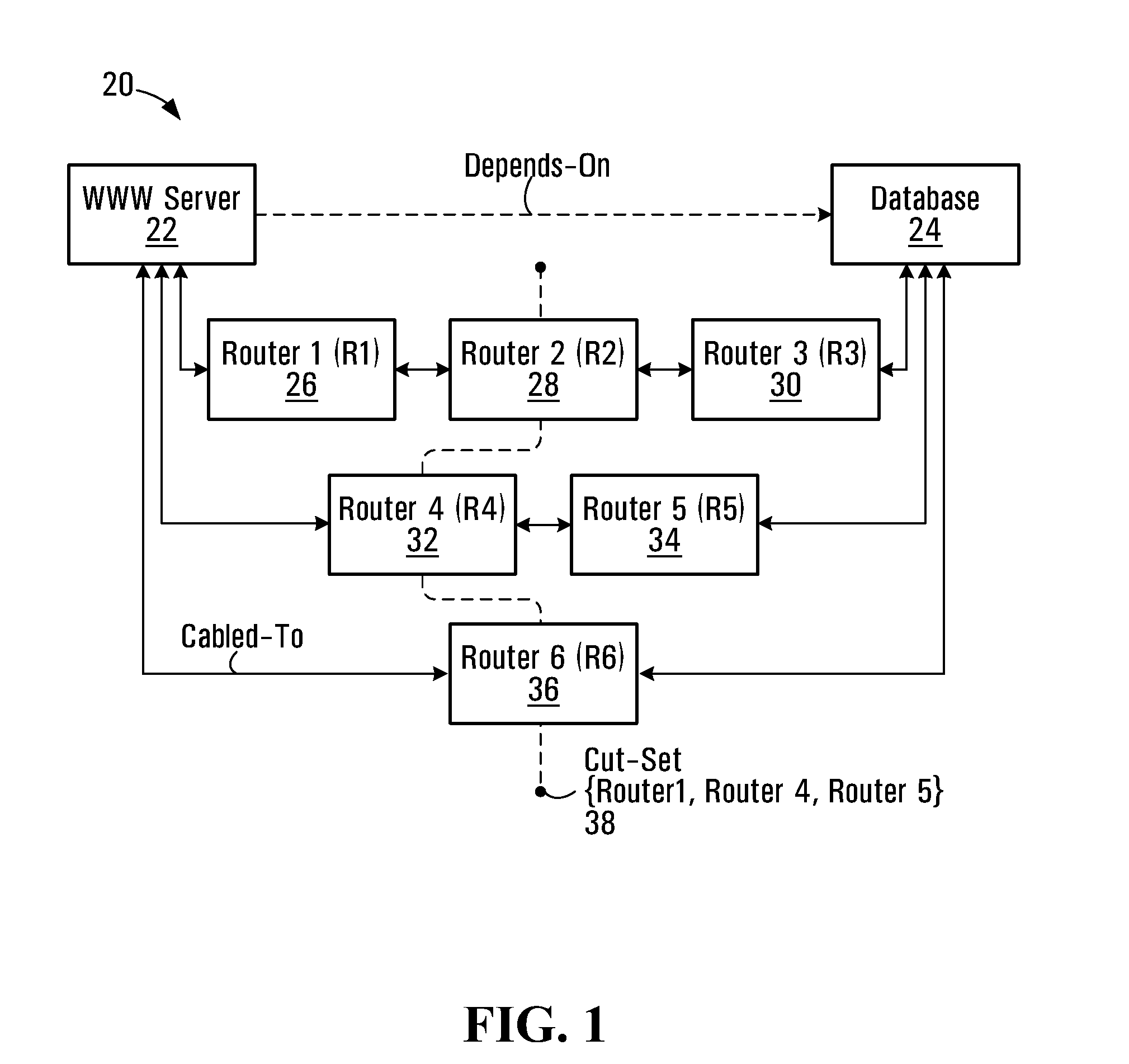Graph-based modeling apparatus and techniques
a graph and modeling technology, applied in the field of electronic modeling, can solve the problems of re-enumeration of cut-sets, severe limitation of usability of a system based on cut-sets, and no mechanism is provided for handling re-enumeration of cut-sets
- Summary
- Abstract
- Description
- Claims
- Application Information
AI Technical Summary
Benefits of technology
Problems solved by technology
Method used
Image
Examples
case # 1
[0100]Model changes that change the topology of a model may be assessed on a case-by-case basis. Examples of events that could cause topology changes in a system, illustratively a communication network, include at least the following, and possibly others:[0101]Case #1: Addition / deletion of a component or model node that is a leaf component or node;[0102]Case #2: Addition / deletion of a component or model node that is a non-leaf component or node;[0103]Case #3: Addition / deletion of a new set of dependent components or model nodes (e.g., a “Depends-on” relationship);[0104]Case #4: Addition / deletion of a relationship between components or model nodes (e.g., a “Cabled-to” relationship).
[0105]These changes may be analysed as described below with the intent to determine which changes affect operational dependencies and which do not, thereby limiting unnecessary subset computation processing. It should be apparent that the addition or deletion of a component from a modeled system will at so...
case # 3
[0114]Considering Case #3, addition / deletion of an operational dependency affects the operational dependencies in a model, and appropriate changes are made to the tables 60, 70, as described below.
[0115]In the case of an addition, no re-computation of existing subsets is required. However, an initial subset computation for the new operational dependency is to be performed and appropriate entries are added to the tables 60, 70, if those tables are provided. For example, adding a new “Depends-on” operational dependency between server 1 and server 2 (FIG. 3) does not alter any existing operational dependencies. A new record for “Server 1 Depends-on Server 2” is inserted into the table 60 with index 3 and subset {C}, and the record for model node C in the table 70 will be updated to reflect the fact that model node C is now a part of the “Server 1 Depends-on Server 2” operational dependency.
[0116]For an operational dependency deletion, the reverse is performed. The corresponding record ...
case # 4
[0117]Case #4, the addition / deletion of a model edge between model nodes in the graph (e.g., a “Cabled-to” relationship), is another scenario where the topology of a model is affected. Some level of subset computation will generally be performed. The extent of subset computation may be different for addition and deletion, as described below.
[0118]Where a model edge is added between model nodes in a model, and both of the end nodes are non-leaf nodes after adding this edge, there might be no way to predict which “Depends-on” operational dependencies will have subsets that are affected by the change. Therefore, a full subset computation for all “Depends-on” operational dependencies in the model is performed. The tables 60, 70 are cleared, the table 60 is updated to identify all subsets for each operational dependency, and the table 70 is updated to identify all model nodes with their associated membership indices from the table 60.
[0119]Adding model edges (e.g., “Cabled-to” relationsh...
PUM
 Login to View More
Login to View More Abstract
Description
Claims
Application Information
 Login to View More
Login to View More - R&D
- Intellectual Property
- Life Sciences
- Materials
- Tech Scout
- Unparalleled Data Quality
- Higher Quality Content
- 60% Fewer Hallucinations
Browse by: Latest US Patents, China's latest patents, Technical Efficacy Thesaurus, Application Domain, Technology Topic, Popular Technical Reports.
© 2025 PatSnap. All rights reserved.Legal|Privacy policy|Modern Slavery Act Transparency Statement|Sitemap|About US| Contact US: help@patsnap.com



